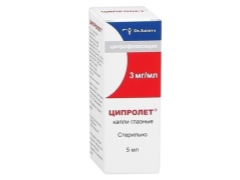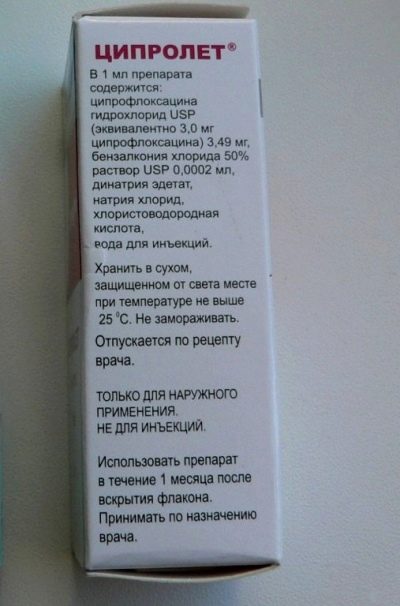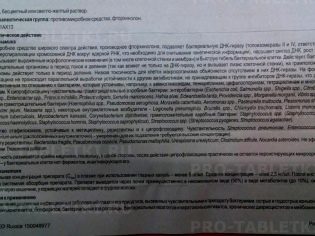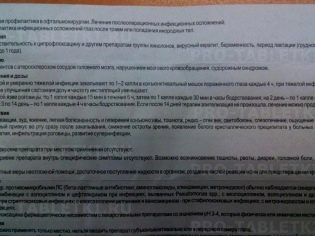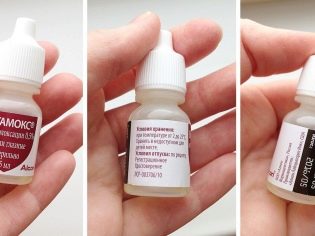Tsiprolet for children: instructions for use
Drugs from the group of fluoroquinolones are in demand in the treatment of many infectious diseases, since they have a wide spectrum and are able to destroy harmful bacteria. One of these drugs is Tsiprolet. It is often prescribed for adults with pneumonia, sinusitis, angina, pyelonephritis, adnexitis and other diseases. If such a medicine is prescribed to a child, it is worth knowing if it is allowed in childhood, and in which cases its use is justified in children.
Release form and composition
"Tsiprolet" is available in India in three forms, which are eye drops, solution for intravenous injections and coated tablets with a dosage of 250 mg and 500 mg. The main ingredient in each of these drug variants is called ciprofloxacin.
Since the solid and injectable forms can adversely affect the formation of the skeleton, in childhood this “Tsiprolet” is not prescribed, and it is acceptable to use the drug in the form of drops only in children due to the predominantly local effect. This form of the drug is prescribed to young patients older than 1 year.
There is also a medication called "Tsiprolet A". This is a tableted medicine, in which, in addition to ciprofloxacin, there is another active compound, tinidazole. This drug is also contraindicated at the age of 18 years.
One milliliter of Tsiprolet eye drops contains 3 mg of ciprofloxacin, which is in this medicine in the form of hydrochloride. The solution itself is clear and usually colorless or slightly yellowish. It is placed in plastic bottles in a volume of 5 ml. Auxiliary substances in this medicine are standard for eye drops ingredients - benzalkonium chloride, water, hydrochloric acid, sodium chloride and edetate disodium.
Operating principle
Ciprofloxacin able to inhibit DNA gyrase - special enzymes in microbial cells. As a result, "Tsiprolet" prevents the growth and division of bacteria, in addition, it provokes changes in the membranes and cell walls of pathogens, which leads to their rapid death.
The drug has a bactericidal effect on Salmonella, Citrobacter, Proteus, Chlamydia, Campylobacter, Escherichia coli, Legionella, Serration, Moraxella, Diphtheria Corynebacterium, Streptococcus, Mycobacterium and many other microorganisms.
Enterococci, clostridia, pseudomonads, treponemas, ureaplasmas and bacteroids can be resistant to the medication.
Indications
Treatment with Tsiprolet is required for various infections of the eyes and lacrimal apparatus, which provoked microorganisms sensitive to ciprofloxacin. Drops are prescribed to children suffering from:
- conjunctivitis;
- blepharoconjunctivitis;
- blepharitis;
- keratoconjunctivitis;
- keratitis;
- corneal ulcers;
- dacryocystitis;
- meybomitom.
The drug is used as a means of prevention, if the child had an operation on the organs of vision, as well as after removing a foreign body from the eye or an eye injury.
Some doctors prescribe this medicine to drip into the nose if a rhinitis of a bacterial nature is found in a child, but most experts doubt the safety of such use of Tsiprolet.
Contraindications
“Tsiprolet” is not prescribed to patients who have previously been found to be hypersensitive to ciprofloxacin, another fluoroquinolone drug, or any of the auxiliary ingredients of the solution. Drops are also not used for viral eye lesions. In case of convulsive syndrome or impaired blood circulation in the brain tissues, treatment with such a remedy should be controlled by a doctor.
Side effects
Some children may experience negative symptoms such as redness, slight soreness, itching or burning sensation after contact with Tsiprolet on the conjunctiva. In rare cases, the drug provokes discomfort in the eye, photophobia, decreased visual acuity, inflammation of the cornea, eyelid edema, and other symptoms. Sometimes during treatment drops appear nausea or allergic reaction. In addition, occasionally patients complain of an unpleasant taste in the mouth.
Instructions for use
The dose of “Tsiprolet” depends on the severity of the infection and in mild cases it is 1 drop, and in case of moderate or severe damage - 2 drops to the affected eye. The frequency of use is also determined depending on the diagnosis.
If the disease is moderately severe or mild, the solution should be dripped into the eyes every 4 hours. In case of severe disease, the medicine must be instilled every hour, and after improvement, the frequency of use is reduced.
The duration of treatment with Tsiprolet ranges from 5 days to several weeks. It is influenced by both the disease in which the drops are prescribed and the patient’s response to therapy. If after 2-3 days of use improvement is not observed, you should contact your ophthalmologist for the selection of another medication.
Overdose
If you drip into your eyes more than 2 drops at a time, it does not affect the general condition of the patient. If a child accidentally drank a solution from an unattended bottle, he may have various negative symptoms, such as vomiting, headache, anxiety, nausea, and so on.
In this situation, you should immediately flush the stomach, and then give the patient a sorbent and a sufficient amount of liquid.
Drug interaction
Since “Tsiprolet” in the form of eye drops acts exclusively in the place of use, this tool is compatible with any other drugs. Moreover, when administered together with metronidazole, aminoglycosides and other antimicrobial drugs, synergism is observed (the action is mutually enhanced). However, any other drops in the eye should be used with Tsiprolet only at intervals of at least 5 minutes.
Features of purchase and storage
Ziprolet eye drops are sold by prescription; therefore, an ophthalmologist must be examined before purchasing such a medicine. The average price of one bottle is 50-70 rubles.
It is important to keep the medicine at home in a dry place where the child will not find it.
The solution should not be heated above +25 degrees or frozen. Shelf life drops - 2 years, but after opening the bottle, it is reduced to one month.
Reviews
On the use of eye drops "Tsiprolet" in children speak mostly positively. The drug is called effective for various bacterial diseases of the eye, as well as inexpensive and easy to use. Only a short period of storage of the opened bottle is attributed to its minuses, and adverse reactions are very rarely detected.
Analogs
If for some reason it is impossible to use “Tsiprolet”, this medicine can be replaced with eye drops that contain the same active ingredient. These drugs are "Cypromed», «Ciprofloxacin"Or" Ciprofloxacin-AKOS ". In addition, the doctor may recommend another fluoroquinolone drug, which is used in ophthalmic practice, for example:
- Zimar;
- «Floksal»;
- Danzil;
- Maxiflox;
- «Levofloxacin»;
- Vigamoks;
- "Signitz".
If you are allergic to Ziprolet, you have to use other antimicrobial or antiseptic agents that drip into your eyes. Among them in childhood the following medicines are in demand.
- «Tobrex». This drug acts on bacteria through the antibiotic tobramycin. It is allowed to use even in newborns.
- «Vitabact». The antibacterial effect of such drops is due to picloxidin. Such a tool can be used from birth.
- "Sulfacyl sodium". This sulfa drug is in demand for various bacterial infections and for their prevention. Children use it from the first days of life.
- «Okomistin». Such drops have antiseptic properties and are appointed from 3 years of age. Their action is provided by miramistin.
- "Sofradex". This medicine is a combination, because in its composition there are three components. It is used not only for eye diseases, but also as ear drops. Children are discharged from the age of 1.
- "Conjunctin". The antiseptic effect of this solution provides decamethoxin. It can be buried in the eyes of a child of any age.
Parents will quickly cope with any eye disease in their child, if they properly carry out the procedure of instillation. Tips from an ophthalmologist will speed up the process of recovery of children.
